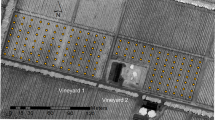Abstract
Drought is a significant disaster in Beijing and it is important to find a method to assess the drought condition. First, this paper collected data of 85 soil monitoring stations in Beijing, such as soil dry bulk densities, saturated water contents, field capacities. Then, spatial variability characteristics of soil physics parameters were investigated by GIS and other three factors, 10 cm soil moisture content, organic matter and saturated water content which notably influenced soil moisture were extracted by Principal Component Analysis (PCA). Furthermore, four different nonlinear methods were put forward to predict crop-root zone soil water. 15555 single daily data from 2011 were used in parameters determination, while 15470 double daily data were used to test. The result showed that the Least Square Support Vector Machine coupling Particle Swarm Optimization Algorithm (PSO-LSSVM) (R 2 = 0. 875) did better than BP Neural Network (R 2 = 0. 840), Generalized Regression Neural Network (GRNN) (R 2 = 0. 850) and Wavelet Neural Network (WNN) (R 2 = 0. 853). As so the POS-LSSVM method was used to evaluate the drought conditions from October 2010 to March 2011 of Beijing, and the result showed that from October 2010 to January 2011, the drought conditions were getting increasingly worse while later relieved from January 2011 to March 2011.






Similar content being viewed by others
References
Deng N, Tian Y (2004) New method in data mining-SVM. Science Press, Beijing
Fletcher R (1987) Practical methods of optimization. Wiley, Chichester
Ian HW, Eibe F (2005) Data mining: practical machine learning tools and techniques. Morgan Kaufmann
Kennedy J, Eberhart RC (1995) Particle swarm optimization[C]//Proc of IEEE International Conference on Neural Networks. IEEE Press, USA, pp 1942–1948
Li J (2001) Method and advances of drought monitoring by remote sensing. J China Hydrol. (04):15–17
Li Y, Tian Y, Ouyang Z, Wang L, Xu T, Yang P, Zhao H (2009) Analysis of soil erosion characteristics in small watersheds with particle swarm optimization, support vector machine, and artificial neuronal networks. Environ Earth Sci 60(7):1559–1568
Mozny M, Trnka M, Zalud Z, Hlavinka P, Nekovar J, Potop V, Virag M (2012) Use of a soil moisture network for drought monitoring in the Czech Republic. Theor Appl Climatol 107(1–2):99–111
Smola AJ (1998) Learning with kernels. Technical University of Berlin, Berlin
Sun L (2004) Research on constructing drought monitoring system using remote sensing data of Beijing. China Agricultural University, Beijing
Suykens JAK, Gestel TV, Brabanter JD, Moor BD, Vandewalle J (2002) Least squares support vector machines. World Scientific Publishing, Singapore
Wang XiZhi, Chang JieTian, Wang LiHe Zheng Yi, Ge ShuChun (2012) Change law of soil moisture content under irrigation condition in Henan Province. J Henan Agric Sci 41(2):73–77
Author information
Authors and Affiliations
Corresponding author
Additional information
Communicated by: H. A. Babaie
Rights and permissions
About this article
Cite this article
Lixi, Z., Pengbo, S., Fang, J. et al. Using monitoring data of surface soil to predict whole crop-root zone soil water content with PSO-LSSVM, GRNN and WNN. Earth Sci Inform 7, 59–68 (2014). https://doi.org/10.1007/s12145-013-0130-6
Received:
Accepted:
Published:
Issue Date:
DOI: https://doi.org/10.1007/s12145-013-0130-6




